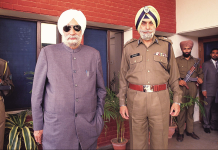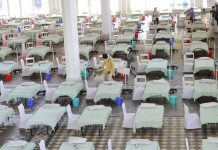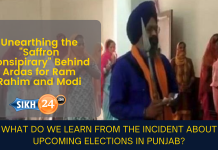I have for some time been thinking about the sad demise of Left parties in the Northern Indian state of Punjab. This is particularly disappointing given the great revolutionary tradition of Punjab dating back to the challenges posed to the feudal order by the Bhagti tradition from the 11th to 15th Century through to the emergence of the Sikh movement. This movement in particular, beginning with Guru Nanak in the late 15th Century through to Guru Gobind Singh in the later 17th and early 18th Century, represented a serious challenge to the ruling classes and their divisive ideologies and practices. Indeed, by the time we get to Banda Singh Bahadur following Guru Gobind Singh we see an uprising by the masses from which the Mogul emperors never recovered.


 Continuing this struggle against power, we see in the 19th Century the establishment of Maharaja Ranjit Singh’s secular and socially conscious rule. A unique feature of this period was the relative harmony that existed amongst diverse peoples of his Sikh empire which at its peak spread from Afghanistan to Delhi. And it was the British that brought this down and established their own capitalist imperial order on the Punjab. But once again we find the people of Punjab mobilising to overthrow what they determined to be unjust colonial power, and the role of the Gaddar Lehar is a glorious example in this regard.
Continuing this struggle against power, we see in the 19th Century the establishment of Maharaja Ranjit Singh’s secular and socially conscious rule. A unique feature of this period was the relative harmony that existed amongst diverse peoples of his Sikh empire which at its peak spread from Afghanistan to Delhi. And it was the British that brought this down and established their own capitalist imperial order on the Punjab. But once again we find the people of Punjab mobilising to overthrow what they determined to be unjust colonial power, and the role of the Gaddar Lehar is a glorious example in this regard.

 In the post 1947 period we see Punjabi’s organising politically to fight for the rights of peasant farmers and dalits. Most notable here is the Naxalite movement. However, we know that the government of Parkash Badal in the 1970’s managed to crush this movement with brutal force. And it was some of the remnants of this movement that once again joined the contemporary Sikh struggle, which this time was crushed by the Congress government through state terror throughout the 1980’s, conveniently labelling it as a sectarian, terrorist secessionist movement. The brutal truth of the horrors of this dark and shameful episode in Punjab’s history is slowly emerging through a combination of forensic investigations by Shaheed Jaswant Singh Khalra and testimonies of ex police offices such as Gurmeet Singh Pinky. One can safely assert that the numbers of extrajudicial killings by the state were anything between 100,000 and 250,000.
In the post 1947 period we see Punjabi’s organising politically to fight for the rights of peasant farmers and dalits. Most notable here is the Naxalite movement. However, we know that the government of Parkash Badal in the 1970’s managed to crush this movement with brutal force. And it was some of the remnants of this movement that once again joined the contemporary Sikh struggle, which this time was crushed by the Congress government through state terror throughout the 1980’s, conveniently labelling it as a sectarian, terrorist secessionist movement. The brutal truth of the horrors of this dark and shameful episode in Punjab’s history is slowly emerging through a combination of forensic investigations by Shaheed Jaswant Singh Khalra and testimonies of ex police offices such as Gurmeet Singh Pinky. One can safely assert that the numbers of extrajudicial killings by the state were anything between 100,000 and 250,000.If the extermination of a generation of Punjab’s youth represents a grave crime against humanity, the utter failure of Left parties to mobilise is nothing less than a political tragedy. Along with the general decline of Left parties globally following the collapse of Communism across the world, the Left’s failure to sufficiently condemn state repression in Punjab during and after 1984 alienated the Sikh masses. Indeed, the Left’s failure to side with the Sikh struggle against state terror and repression was a gross error of judgement. It was particularly disappointing given that the popularity of Jarnail Singh Bhindrawale was that he was basically a peasant leader/activist who dare take on the corrupt political establishment and state repression; Punjab’s own Che Guevara. Indeed, some Naxalites were attracted to his cause. It is also worth remembering that the Anandpur Resolution, which was after all the reason for the Sikh struggle at the time, was calling for the establishment of a secular socialist state in Punjab that would be part of a semi autonomous union of Indian states.
Because of the failure of Left parties at the time many progressives had no choice but to join ‘religious’ groups. The result has been that we have seen the exponential growth of deras (Religious orders led by ‘god’ men) which has in effect become the new opium of the masses. However, with the emergence of Aam Adami Party (Ordinary People’s Party) I believe the tide has turned and once again there is an option for progressive left secular activists to influence the political future of Punjab. 2016 and 17 are likely to be crucial moments for the masses to rise against both the ruling elites and the ‘God men’ who serve the rules by exploit faith and deviating people’s attention from the real causes of their misery. The recent Sarbat Khalsa gathering of over 500,000 ‘ordinary’ people is an illustration that the masses in Punjab have once again regained their courage to take on the ruling powers which have become criminally corrupt. All progressive Left leaning activists need to form a grand coalition against the moribund and criminally corrupt established parties that exploit religious sentiment and offer the people of Punjab a new future.






The author of this article, given his background, exemplifies his poor understanding of human nature with his inability to understand how the common man thinks with this Marxism-biased article.
“Indeed, the Left’s failure to side with the Sikh struggle against state terror and repression was a gross error of judgement. ”
The left DOESN’T CARE about the Sikh struggle. In fact, the left doesn’t care about Sikhs, Sikhism or religion altogether. Leftist (basically soft-Marxist) parties are nothing but leeches on any country. They are never the ones to stand up to oppression, let alone fight for any justice against tyranny or sacrifice their lives, BECAUSE THEY ARE NOT IDEOLOGICALLY DRIVEN.
Leftists/secularists/Marxists are simply driven by short-term self-interest and always support the establishment as long as they are getting their share of scraps. They do not care about freedom, sovereignty, inalienable rights, etc. They only go up in arms when the state can no longer pay them off with scarps. If things get really bad, they may join a right-wing ideologically motivated uprising (religion) to vent their anger and demand for more scraps.
“It was particularly disappointing given that the popularity of Jarnail Singh Bhindrawale was that he was basically a peasant leader/activist who dare take on the corrupt political establishment and state repression; Punjab’s own Che Guevara.”
This statement is ridiculous on so many levels I’m not even sure where to start. Sant Jarnail Singh Bhindranwale, was first and foremost, a Sikh religious leader, and not “basically a peasant leader/activist.” Sant Bhindranwale was driven by Sikh ideology, which intrinsically requires one to fight against state oppression and tyranny. Being from a farming family, he also naturally represented the grievances of the rural agrarian masses, which at the time, were tantamount due to repeated crop failures and lack of any support from the State.
The 1984 uprising at its core was a religious uprising, backed by the rural agrarian masses. If Sikhs were treated with fairness by the Indian Government, 1984 would never had happened.
He was not “Punjab’s own Che Guevara.”, a Marxist revolutionary. The author, to make such a brazen and shallow statement to compare the two, doesn’t understand that the two were driven by totally different reasons.
“However, with the emergence of Aam Adami Party (Ordinary People’s Party) I believe the tide has turned and once again there is an option for progressive left secular activists to influence the political future of Punjab.”
AAP is on ascent in Punjab due to lack of any viable alternatives as the masses of ignorant Punjabis have finally figured out that Badal Dal is a fraud (honest Gursikhs always known this). Even religious Sikhs support AAP since Badal Dal must go if Punjab is to ever start recovering from the extraordinary damage that Badal Dal has inflicted on Punjab since the last 8 years of (mis)rule.